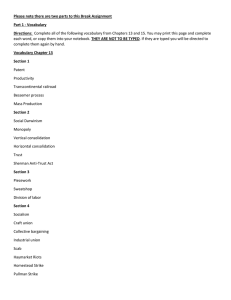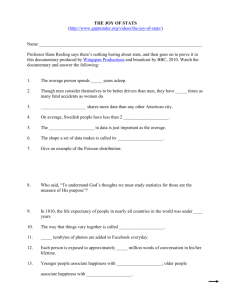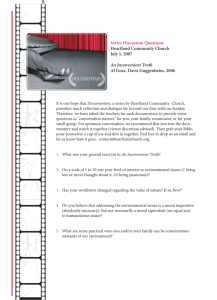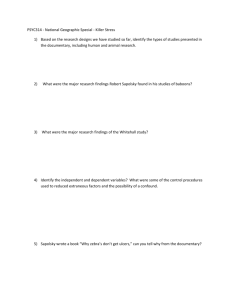Gilded Age Documentary Project
advertisement
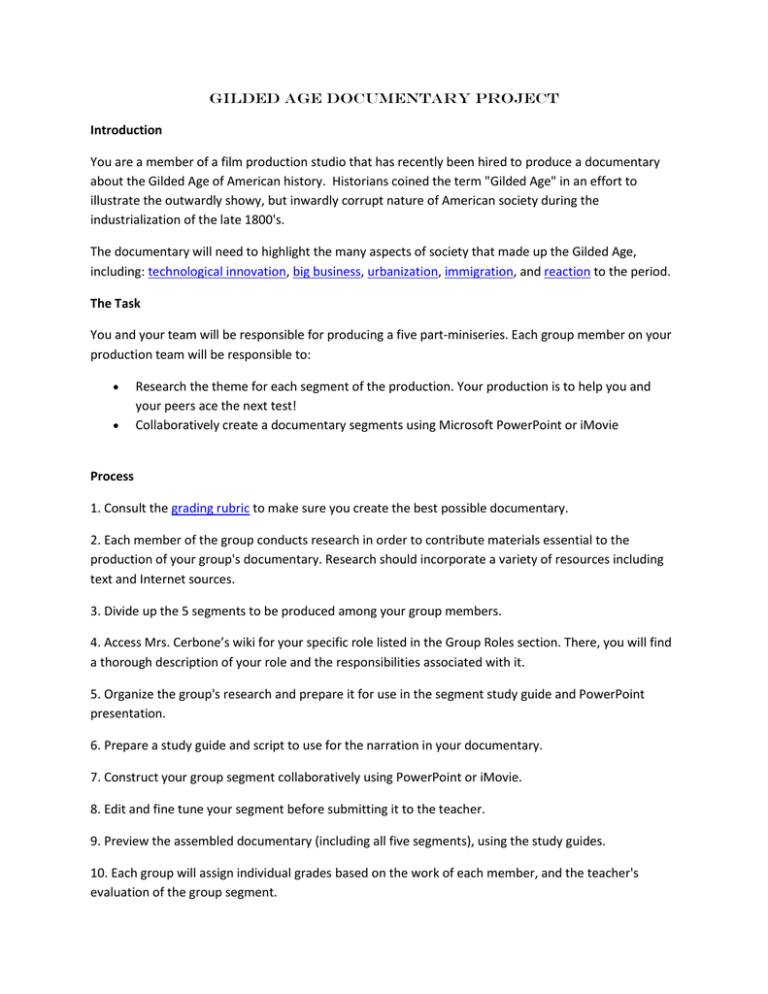
Gilded Age Documentary Project Introduction You are a member of a film production studio that has recently been hired to produce a documentary about the Gilded Age of American history. Historians coined the term "Gilded Age" in an effort to illustrate the outwardly showy, but inwardly corrupt nature of American society during the industrialization of the late 1800's. The documentary will need to highlight the many aspects of society that made up the Gilded Age, including: technological innovation, big business, urbanization, immigration, and reaction to the period. The Task You and your team will be responsible for producing a five part-miniseries. Each group member on your production team will be responsible to: Research the theme for each segment of the production. Your production is to help you and your peers ace the next test! Collaboratively create a documentary segments using Microsoft PowerPoint or iMovie Process 1. Consult the grading rubric to make sure you create the best possible documentary. 2. Each member of the group conducts research in order to contribute materials essential to the production of your group's documentary. Research should incorporate a variety of resources including text and Internet sources. 3. Divide up the 5 segments to be produced among your group members. 4. Access Mrs. Cerbone’s wiki for your specific role listed in the Group Roles section. There, you will find a thorough description of your role and the responsibilities associated with it. 5. Organize the group's research and prepare it for use in the segment study guide and PowerPoint presentation. 6. Prepare a study guide and script to use for the narration in your documentary. 7. Construct your group segment collaboratively using PowerPoint or iMovie. 8. Edit and fine tune your segment before submitting it to the teacher. 9. Preview the assembled documentary (including all five segments), using the study guides. 10. Each group will assign individual grades based on the work of each member, and the teacher's evaluation of the group segment. Group Roles Technology Segment Technology, and an abundance of natural resources, were the driving forces behind the Industrial Revolution in the United States. The telegraph, railroads, the telephone, and ultimately the use of electricity led to the shift from an agrarian to an industrial America. Required Content: Industrial Revolution Use of Natural Resources: o Iron o Coal o Oil Transcontinental Railroad Inventors and their Inventions: o Samuel F. B. Morse o Henry Bessemer o Alexander Graham Bell o Thomas Alva Edison Big Business Segment Laissez-faire capitalism ruled the day during the beginning of the Industrial Revolution in the United States. In this atmosphere of unbridled money-making, numerous types of business organizations gave rise to Big Business. Were the leaders of these companies Captains of Industry or Robber Barons? While some used ruthless business practices to wipe out their competition and earn large profits, others gave enormous sums of money to charities and their communities. Required Content: Laissez-Faire Capitalism: o Adam Smith's The Wealth of Nations Forms of Business Organization: o Monopoly o Conglomerate o Pool o Trust o Holding Company Entrepreneurs (Robber Barons or Captains of Industry?): o Andrew Carnegie o John D. Rockefeller o J. Pierpont Morgan o Jay Gould o Henry Ford Conspicuous Consumption Philanthropy Urbanization Segment Urbanization was a direct result of the Industrial Revolution in the United States. Burgeoning factories were centralized in cities which offered a central location for resources and workers to fuel their production. Immigrants and displaced rural workers flooded cities in the hopes of finding employment. Throughout the Gilded Age there were several positive, as well as negative, effects that can be attributed to urbanization. Required Content: Negative Effects of Urbanization: o Housing (tenements, slums, etc.) o Health (disease, sanitation, etc.) o Working Conditions (child labor, etc.) o Political Machines (Tammany Hall, graft, etc.) Positive Effects of Urbanization: o New Technologies (elevators, skyscrapers, street lighting, water and sewage systems, etc.) o Cultural Benefits (museums, theaters, parks, libraries, education, etc.) Philosophies: o Puritan Work Ethic o Social Darwinism (Horatio Alger, etc.) Immigration Segment The United States has always been a nation of immigrants. However, during the Gilded Age, immigration to America increased tremendously. Not only were more people coming to the United States than ever before, but they were also coming from different places, and in doing so they added to the culture of America. But was America becoming a "melting-pot," or a "salad-bowl" of differing cultures? Required Content: Periods of Immigration: o Colonial Immigration (time period, place of origin, difficulties, etc.) o "Old" immigration (time period, place of origin, difficulties, etc.) o "New" Immigration (time period, place of origin, difficulties, etc.) Reaction Against Immigration: (this will include pre-Gilded Age info) o Nativism o Know-Nothing Party o Chinese Exclusion Act of 1882 ("Yellow Peril") o National Origins Acts (1924, 1929) Theories of Immigration: o "Melting-Pot" Theory o Assimilation o "Salad-Bowl" Theory (Pluralism) o Reactions Segment The Gilded Age was a period of immense change in the United States. All of the abuses and problems of the time generated many different reactions- most directed at reform. Slowly, government regulations began to reign in the abuses of big business. At the same time, social reformers actively sought to correct the problems evident in American cities. Required Content: Granger Movement: o Railroad Practices (pools, rebates, etc.) o Railroads=Public Utility o Bloc Voting o Granger State Laws o Munn v. Illinois (1877) o Wabash Case (1886) o Interstate Commerce Act (1887) Sherman Antitrust Act (1890) Unionism: o Collective Bargaining o Knights of Labor o American Federation of Labor o International Ladies' Garment Workers Union Early Reformers: o Thomas Nast o Jane Addams (Hull House) Evaluation Individual Grading While cooperation and team work are key to this project, it is not uncommon for some group members to work to a lesser or to a greater degree than others. To address this concern, individual grades will be determined based on the points earned by the project, and based on the group's evaluation of each of its members. The executive producer will keep a record of the daily attendance and activities of each group member. After the group project has been graded, the group will collaboratively determine the grade of each member of the group. For example, if the project earns a total of 85 points, the group will need to decide how to fairly distribute 85 points (85 points X 4 members) among the members of the group. Attendance, work ethic, and cooperation are some of the factors that a group should use in order to determine how many points to award to each member. If problems arise during this process that cannot be peaceably worked out by the members of the group, they should consult the teacher for assistance. Project Grading As we discussed in class, a high-quality documentary has a certain look and feel to it, which we are going to try to emulate using PowerPoint and/or iMovie. Based on the criteria that we developed in class, please keep the following grading rubric in mind as you collaboratively create your segment: Criteria Score Segments 1 Factual Content-The information included in the documentary is accurate and relevant to the topic, and includes all of the required items listed on the Documentary Segments page. Use of Primary Sources-Several relevant primary sources (e.g., photographs, Supreme Court rulings, Federal legislation, personal accounts, etc.) have been used to provide information about the content contained in the documentary segment. Media Use-The sounds, images, animations, and slide transitions that are used are both relevant and purposeful. Organization-The documentary segment is organized in a logical manner, making it easy to understand the information that is being presented. Study Guide-The study guide acts as an outline of the documentary, providing students with a resource to review the material presented. The study guide should closely follow the presentation of the documentary. Formatting-The segment maintains the formatting required to create a uniform class documentary (e.g., background color, font size, font type, font color, etc.) and is between 10 and 15 minutes in length. 2 3 4 5 Total Points Grade Each of these criteria will be rated according to the following point scale: Score Meaning 3 Excellent-This criteria has been met in every possible way, and may even exceed expectations. 2 Acceptable-This criteria has been mostly addressed, however, there is room for improvement. 1 Sub par-Some elements have been met, but most of the criteria fails to be addressed. 0 Incomplete-This criteria has not been addressed in any meaningful way or has not been completed.
